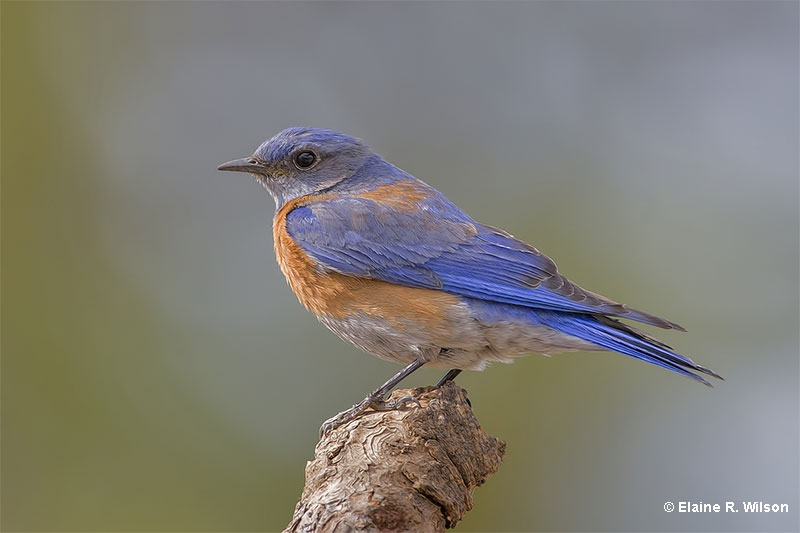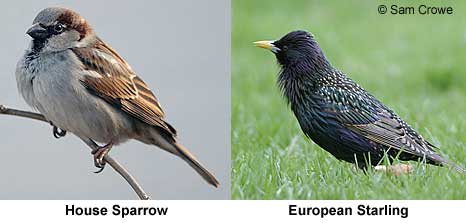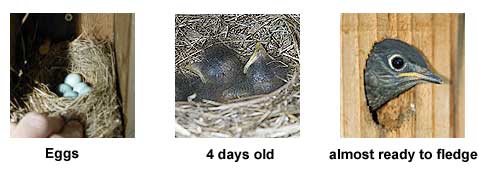
On this page
ANTICIPATION! What to understand before setting up your first bluebird box.
You’ve read the section on bluebird boxes. You purchased a bluebird box or built your own with a design approved by the North American Bluebird Society. The nest box has been placed in the best location you have available. Now it’s the bluebird’s turn to do the work!
Well, not quite.
| THE FIRST RULE OF NEST BOXES!
Do not put up any nest box, bluebird or otherwise, unless you are committed to monitoring and controlling who uses it. Both the European Starling and House Sparrow compete with native species for nesting locations. They will readily use nest boxes designed for many different species of native birds. House sparrows will even kill adult and young bluebirds in the nest. Learn to identify House Sparrows and starlings and their nests. If either species is observed trying to nest in your bluebird box, the nesting material should be removed as soon as possible. You may have to remove it several times. Raising House Sparrows and starlings is very detrimental to native species. Starlings are easily controlled by selecting a nest box with the correct hole size but House Sparrows may require more direct intervention. |

House Sparrows and European Starlings are introduced species that compete with bluebirds for nesting locations.
If you have boxes that have been up all winter, inspect (and clean as needed) in early spring. Start by peeking carefully into the nest box to check for hornet or wasp nests attached to the top of the box. Remove any such nests while taking appropriate safety precautions for yourself.
If it appears that mice have nested in the box, take special care. A respiratory disease called Hantavirus Pulmonary Syndrome can be spread from rodents to humans. One of the most common methods of contraction is through breathing in dust that has been contaminated with the disease. To protect yourself, wear rubber gloves and avoid inhaling any dust if cleaning the nest box after mice have sheltered there. You may wish to wear a mask/respirator with HEPA filter.
SUCCESS
At last, something other than a House Sparrow has adopted the home you made available. It’s a bluebird and what a beauty! Now the fun starts! (One of several other native bird species may have moved in to set up housekeeping. You can learn more about some of the more common friends that might move in by visiting the other cavity nesters. Other native cavity nesters should not be evicted from the bluebird box. Just enjoy their presence.)
Double returns! Becoming involved in the raising of the bluebird family not only adds to your enjoyment and satisfaction… it also improves nesting success. When a nest is monitored with care, the adult bluebirds will not abandon their nest, eggs or young.
Monitoring (nest checks) involves carefully opening the nest box, observing the contents of the nest, responding to any undesirable conditions and (if you wish) recording the results of your nest check. If chicks are present, care should be taken to insure they do not jump from the nest box. Be sure to close the box securely after your nest check.
When to monitor?
Nest box monitoring should be performed during mild, calm and dry weather conditions. The goal is to keep the eggs or young as warm and dry as possible. Nest checks should occur on a 4 to 7 day cycle. The timing is not critical. You may wish to check nests on a shorter cycle time if trying to control blowflies or House Sparrows and stay with the 7 days if everything appears to be going well.
How to monitor?
Do your nest checks as quietly and quickly as possible. If it is necessary to remove more than one chick at a time from the nest, place them in a dry, protected container to shield them from wind, cold and the sun. Keep in mind that handling of eggs and young should occur only in special circumstances, such as heavy blowfly or ant infestation or very wet nesting material, etc. These conditions are described in the next section.
If you are removing nesting material because of blowflies, wet nesting material etc., dispose of any used nesting material far from the nest box. Doing so will ensure that you are not alerting predators to the presence of the nest site.
It is good practice to wear thin rubber gloves and/or to wash your hands thoroughly after handling birds or cleaning the nest box.
What to monitor?
As a top bluebird guardian you will want to start by determining the approximate stage of the nesting process. Bluebirds lay one egg a day until the entire clutch is complete. Four to six pale blue (sometimes white) eggs are usually laid. It is good practice to record the number of eggs, young and dates.
The incubation period for bluebirds is about 13-14 days. Chicks fledge and leave the nest about 17-21 days after hatching. Do not open the nest box after the chicks are 13 days old (16 days for the mountain bluebird) or they might be encouraged to leave the nest prematurely. (Check the individual species profiles for more exact information on incubation and fledging.)
If a young bird does leave the nest box prematurely, place the bird back in the nest box and close the hole with a rag, sock or other material. The birds will often calm down after a few minutes and the cover can be removed.
A handy tool to have around is a thin piece of plywood or other material that has been drilled with a 1 1/4″ inch hole. In cases where the young bird continues to leave the nest, this piece of wood can be placed over the regular hole (use a screw or duct tape). The adults will be able to continue to feed the young birds but the young will not be able to leave the nest through the smaller hole. Remove the cover at night (the night of the same day) and everything should be back to normal. Make sure you do not leave the cover in place past the anticipated fledge date of the young birds.
Insect pests
In some areas blowfly parasitism can be a problem and ants have been known to invade bluebird boxes. Look for the presence of blowfly larvae on the chicks or under the nest.
Moisture
After periods of heavy rains, the nesting material may become saturated with water. In such conditions you can replace the existing nest with clean (no insects), dried lawn clippings or grasses in a shape similar to that of the original nest.
Injured or dead bird
It is illegal for unlicensed individuals to care for or handle bluebirds (or most other migratory and native species). If you find an injured bird, you should first contact a local rehabilitation center or your state Fish and Wildlife Service for advice.
Orphaned birds
If you are positive that baby bluebirds have been orphaned in the nest box, contact a local rehabilitation facility or your state Fish and Wildlife Service.

A fond farewell
If you are lucky, you might observe the young birds leaving the safety of their nest box. Watching “YOUR” bluebirds grow and head out on their own is a fun and exciting event that you helped create. Congratulations on a job well done!
Some bluebird managers remove the old nesting material after nesting is complete and all the young have headed out to their new lives. Removing the old nest material seems to encourage re-nesting, so some managers remove the old nest as a matter of course.
You do not need to sterilize the box. Just wipe it out with a dry towel. If dried mud or dirt is present you may wish to use clean water to help remove it or just scrape out the materials with a putty knife or stiff brush.
After nesting is complete, some bluebird box managers will close off the entry to prevent mice from moving in during the winter. Bluebirds will often produce two and, in the south, even three broods, so be careful in making a decision to close the box. Others leave the boxes open year round, so its up to you.
If you have recorded information on your nest box(es) you may wish to report the results to a local bluebird society or to the the North American Bluebird Society via their Website. The record sheet enclosed with this product conforms to the questions asked by the NABS.

